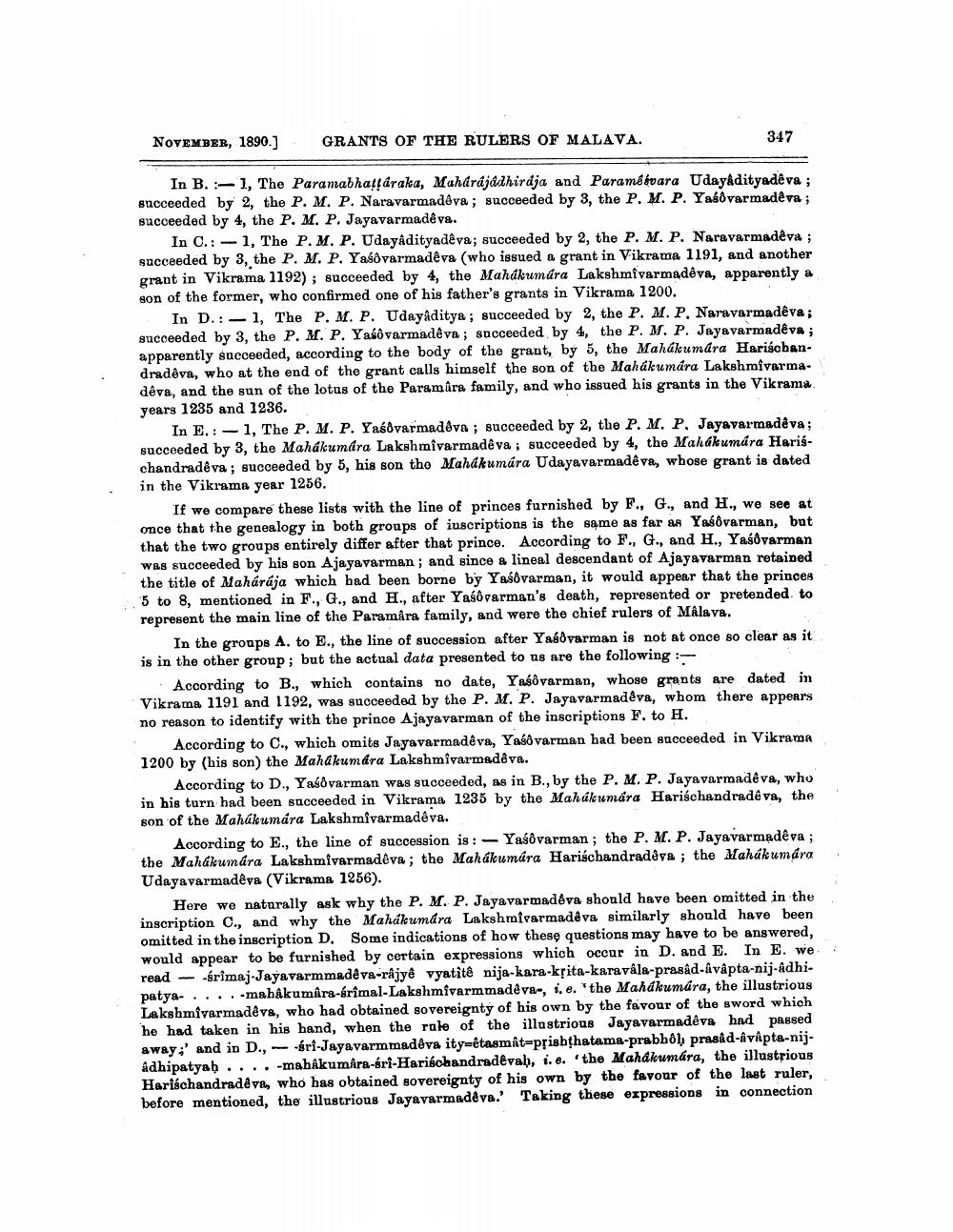________________
NOVEMBER, 1890.)
GRANTS OF THE RULERS OF MALAVA.
347
In B. :-), The Paramabhatļáraka, Maharajathirdja and Paramé kvara Udayadityadêva ; succeeded by 2, the P. M. P. Naravarmadêya ; succeeded by 3, the P. M. P. Yaśðvarmadêva ; succeeded by 4, the P. M. P. Jayavarmadêva.
In C.: -1, The P. M. P. Udayadityadêva; succeeded by 2, the P. M. P. Naravarmadêva ; succeeded by 3, the P. M. P. Yaśðvarmadêva (who issued a grant in Vikrama 1191, and another grant in Vikrama 1192); succeeded by 4, the Mahakumára Lakshmivarmadêva, apparently a son of the former, who confirmed one of his father's grants in Vikrama 1200.
In D.:-1, The P. M. P. Udayaditya; succeeded by 2, the P. M. P. Naravarmadêva; succeeded by 3, the P. M. P. Yako varmadêva; succeeded by 4, the P. M. P. Jayavarmadêva ; apparently succeeded, according to the body of the grant, by 5, the Mahálumdra Hariśchan. dradêva, who at the end of the grant calls himself the son of the Mahákumára Lakshmivarma. déva, and the sun of the lotus of the Paramüra family, and who issued his grants in the Vikrama years 1235 and 1236.
In E.:-1, The P. M. P. Yaśvarmadáva ; succeeded by 2, the P. M. P, Jayavarmadêva; succeeded by 3, the Mahákumara Lakshmivarmadê va ; succeeded by 4, the Mahákumára Harischandradê va ; succeeded by 5, his son tho Mahákumára Udayavarmadêva, whose grant is dated in the Vikrama year 1256.
If we compare these lists with the line of princes furnished by F., G., and H., we see at once that the genealogy in both groups of inscriptions is the same as far as Yaśðvarman, but that the two groups entirely differ after that prince. According to F., G., and H., Yaśðvarman was succeeded by his son Ajayavarman; and since & lineal descendant of Ajayavarman retained the title of Mahárája which had been borne by Yaśðvarman, it would appear that the princes 5 to 8, mentioned in F., G., and H., after Yaśôvarman's death, represented or pretended to represent the main line of the Paramâra family, and were the chief rulers of Mâlava.
In the groups A. to E., the line of succession after Yaéðvarman is not at once so clear as it is in the other group; but the actual data presented to us are the following:
According to B., which contains no date, Yaśôvarman, whose grants are dated in Vikrama 1191 and 1192, was succeeded by the P. M. P. Jayavarmadêva, whom there appears no reason to identify with the prince Ajayavarman of the inscriptions F. to H.
According to C., which omits Jayavarmadêva, Yaśðvarman had been succeeded in Vikrama 1200 by (his son) the Mahkumdra Lakshmivarmadêva.
According to D., Yaśðvarman was succeeded, as in B., by the P. M. P. Jayavarmadêva, who in his turn had been succeeded in Vikrama 1235 by the Mahákumára Harischandradê va, the son of the Mahákumára Lakshmivarmadêva.
According to E., the line of succession is :- Yaśôvarman; the P. M. P. Jayavarmadêva ; the Mahakumára Lakshmivarmadêva; the Mahákumúra Harischandraddva ; the Mahákumara Udayavarmadêya (Vikrama 1256).
Here we naturally ask why the P. M. P. Jayavarmadeva should have been omitted in the inscription C., and why the Mahakumdra Lakshmivarmadêva similarly should have been omitted in the inscription D. Some indications of how these questions may have to be answered, would appear to be furnished by certain expressions which occur in D. and E. In E. we : read --srimaj-Jayavarmmadêva-rajye vyatitê nija-kara-krita-karavâla-prasad-avâpta-nij-adhipatya-.....mahakumara-brimal-Lakshmivarmmadêva, s. e. 'the Mahkumára, the illustrious Lakshmivarmadêva, who had obtained sovereignty of his own by the favour of the sword which he had taken in his hand, when the role of the illustrious Jayavarmadêva had passed away;' and in D., --sri-Jayavarmmadêva ity=ētasmat-prishthatama-prabhôh prasad-âvâpta-nijadhipatyah....mabakumira-bri-Hariéchandradevah, i.e. 'the Mahakumára, the illustrious Hariéchandradêve, who has obtained sovereignty of his own by the favour of the last ruler, before mentioned, the illustrious Jayavarmadêya.' Taking these expressions in connection




